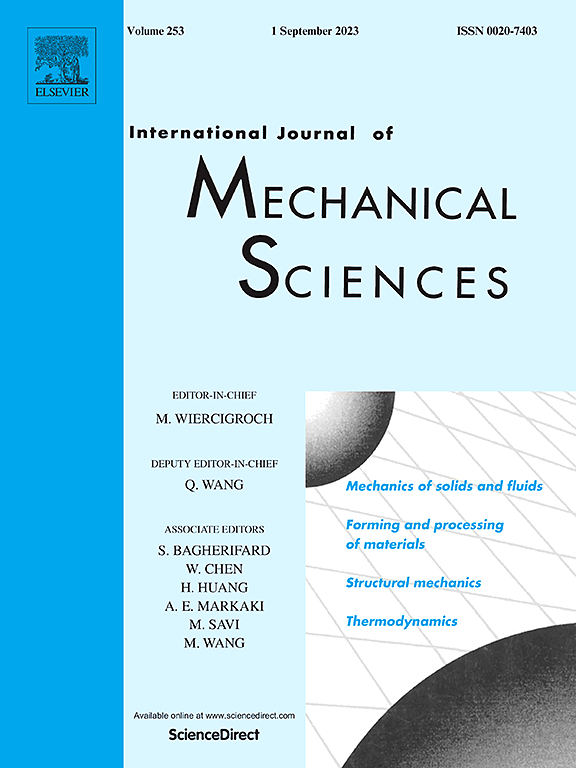折纸阵列:结构设计与带隙调制
IF 7.1
1区 工程技术
Q1 ENGINEERING, MECHANICAL
International Journal of Mechanical Sciences
Pub Date : 2025-07-16
DOI:10.1016/j.ijmecsci.2025.110611
引用次数: 0
摘要
折纸启发的结构阵列由于其独特的几何结构和力学性能,在声场中显示出巨大的潜力。本文采用实验与理论相结合的方法研究了四种折纸柱结构(Accordion、Kresling、Miura和Yoshimura ori)的压缩特性和声带隙特征。力学测试结果表明,Kresling折纸结构在压缩过程中表现出优越的展开特性,其力学性能优于其他三种折纸结构。Kresling折纸结构在整个折叠展开周期中表现出明显的声学灵敏度,具有依赖于部署和动态可调的带隙特性。在此基础上,我们设计了Kresling折纸阵列,分别将交叉折纸、切割折纸和Miura折纸作为衬底与Kresling柱结合,研究了它们的复合结构带隙特性。结果表明,折纸结构的不同组合对整体声学性能有显著的调节作用,为新型高性能声学材料的设计奠定了理论基础。通过系统的研究,本研究不仅为折纸结构的声学应用建立了实验数据支持和理论框架,而且丰富了声学超材料领域的基础认识。本文章由计算机程序翻译,如有差异,请以英文原文为准。

Kresling origami arrays: Structural design and bandgap modulation
Origami-inspired structural arrays demonstrate promising potential in the acoustic field due to their unique geometric configurations and mechanical properties. This study investigates the compressive characteristics and acoustic bandgap features of four origami column structures (Accordion, Kresling, Miura, and Yoshimura ori) through a combined experimental and theory approach. Mechanical testing results reveal that the Kresling origami structure exhibits superior deployable characteristics during compression, outperforming the other three origami structures in mechanical performance. The Kresling origami structure demonstrates pronounced acoustic sensitivity throughout its folding–unfolding cycle, featuring deployment-dependent and dynamically adjustable bandgap characteristics. Building upon these findings, we designed Kresling origami arrays by integrating cross origami, cut origami, and Miura origami as substrates combined with Kresling columns, respectively, to investigate their composite structural bandgap characteristics. Results have demonstrated that different combinations of origami structures exert a significant regulatory effect on overall acoustic performance, which establishes a theoretical basis for the design of new high-performance acoustic materials. Through systematic investigation, this study has not only established experimental data support and a theoretical framework for the acoustic application of origami structures but also enriched the fundamental understanding in the field of acoustic metamaterials.
求助全文
通过发布文献求助,成功后即可免费获取论文全文。
去求助
来源期刊

International Journal of Mechanical Sciences
工程技术-工程:机械
CiteScore
12.80
自引率
17.80%
发文量
769
审稿时长
19 days
期刊介绍:
The International Journal of Mechanical Sciences (IJMS) serves as a global platform for the publication and dissemination of original research that contributes to a deeper scientific understanding of the fundamental disciplines within mechanical, civil, and material engineering.
The primary focus of IJMS is to showcase innovative and ground-breaking work that utilizes analytical and computational modeling techniques, such as Finite Element Method (FEM), Boundary Element Method (BEM), and mesh-free methods, among others. These modeling methods are applied to diverse fields including rigid-body mechanics (e.g., dynamics, vibration, stability), structural mechanics, metal forming, advanced materials (e.g., metals, composites, cellular, smart) behavior and applications, impact mechanics, strain localization, and other nonlinear effects (e.g., large deflections, plasticity, fracture).
Additionally, IJMS covers the realms of fluid mechanics (both external and internal flows), tribology, thermodynamics, and materials processing. These subjects collectively form the core of the journal's content.
In summary, IJMS provides a prestigious platform for researchers to present their original contributions, shedding light on analytical and computational modeling methods in various areas of mechanical engineering, as well as exploring the behavior and application of advanced materials, fluid mechanics, thermodynamics, and materials processing.
 求助内容:
求助内容: 应助结果提醒方式:
应助结果提醒方式:


